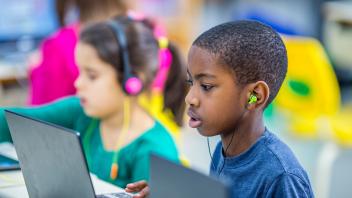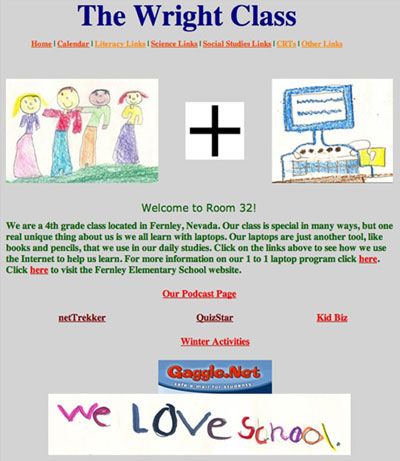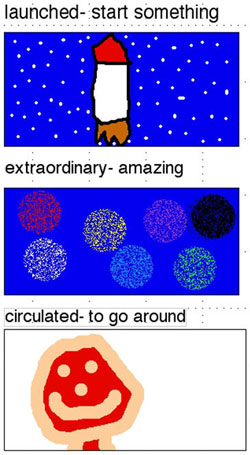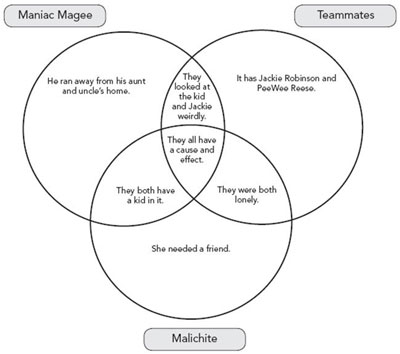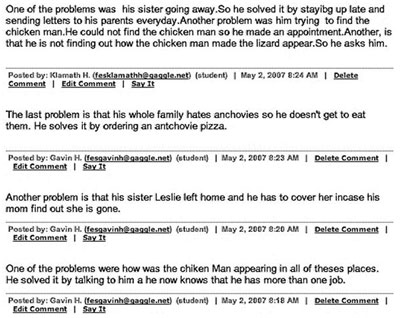As new literacies that include digital and media technologies evolve, preparing students to understand and adjust to these literacy demands is critical to current and future expectations for pleasure and work (International Reading Association, 2001; Leu, Mallette, Karchmer, & Kara-Soteriou, 2005). For instance, teachers may identify with past models of literacy that are paper and pencil bound; however, new conceptions involve continually changing views of reading and writing, particularly with the advent of the Internet (Leu et al., 2004; Warschauer, 2006). These new literacies include innovative text formats (multiple media or hybrid texts; Lemke, 1998), new reader expectations (reading nonlinearly; Warschauer, 2006), and new activities (website publication; Leu et al., 2004). They extend traditional literacy experiences with comprehension of information on the Internet; effective use of search engines to locate information; evaluation of Internet sources; communication using e-mail, texts, and chats; and the use of word processing programs (International Society for Technology in Education, 2007).
The Internet has caused educators to confront issues related to new technologies, as previous technological innovations have never been adopted so rapidly and in so many places simultaneously. The Internet allows for immediate dissemination of information through the click of a single link, for instance (Warschauer, 2006). Moreover, Internet access has become common in schools. In 2005, approximately 95% of K-12 classrooms in the United States had Internet access (Parsad & Jones, 2005). Additionally, 80% of kindergartners use computers and over 50% of children younger than 9 years old use the Internet (Goldberg, Russell, & Cook, 2003). However, the average of U.S. students’ use of computers in school was 12 minutes per week (Wells & Lewis, 2006). This descriptive data points out that computers and Internet access are available to students, but most students do not have sufficient time in school with this technology to develop new literacies.
Bringing new literacies into a classroom is not an easy task for a teacher, especially when two thirds of teachers feel underprepared to use technology (Kajder, 2005). Teachers face additional challenges as well. These include problems with resources (lack of technology, time, or technical support), teacher knowledge and skills (inadequate technological and pedagogical knowledge), school leadership (lack of school planning or scheduling), teachers’ attitudes and beliefs (not valuing or being fearful of the use of new technologies), and assessments (traditional rather than matching new literacies’ expectations; Hew & Brush, 2007). Additionally, Leu et al. (2005) identified the following three important points to ponder before bringing new literacies to classrooms:
- Simply using software programs on computers does not prepare students for new literacies’ expectations.
- New literacies are deictic in that they constantly change and require teachers to embrace these changes.
- New literacies are essential in classrooms so that equal opportunities are offered to all students.
Although educators may assume that bringing new literacies into the classroom, especially through the use of a laptop for each child (one-to-one laptops), is a new technological innovation in education, the reality is that these structures have been in existence for almost 20 years (Dunleavy, Dexter, & Heinecke, 2007). The first documented use of one-to-one laptops was in Melbourne at a private girls’ school in 1990 (Johnstone, 2003). In the late 1990s, Microsoft’s initiative, Anytime Anywhere Learning Program, brought laptop learning to 1,000 schools. By 2005, 55% of U.S. schools had instructional laptops, although not necessarily one-to-one laptop classrooms (Warschauer, 2006). Many schools used carts with laptops with wireless access to support instruction as a substitution or transition to one-to-one laptop classrooms.
Warschauer’s (2006) research found that laptops and connections to the Internet provided scaffolding for many classroom topics, thus building background knowledge. He noted increased student engagement in wireless classrooms as students participated in more diverse writing activities, analysis of reading, and use of media-production software. Finally, he observed how students gained control of reading on the page as well as the screen. The students realized that there was more to a computer than games or chatting and gained practice in reading for a variety of purposes, such as interpreting the textual and visual elements in a document and knowing how to navigate and find information.
As more classrooms and schools adopt one-to-one laptop instruction, the need to document the work of teachers and students in such settings is important (Dunleavy et al., 2007). The descriptions found in this article provide the pragmatic details of making such a transition in instruction and can serve as roadmaps for teachers considering such a shift in their instructional practice. We have responded to the need for rich description of exemplary new literacies instruction by sharing Todd Wright’s journey in bringing laptops and new literacies into his school and classroom. Todd (second author) teaches at Fernley Elementary, a rural Nevada elementary school with about 565 students. The majority of students are white (68%) with the largest minority group being Hispanic (24%). Approximately 45% of students qualify for free or reduced-cost lunch.
Todd's classroom through the experiences of Michael
In most schools, the opening day is spent with students coming to know their new teacher and classmates, getting materials, and learning the new rules and expectations. Imagine the excitement on fourth-grade students’ faces when, in addition to meeting their teacher, Mr. Wright, and their classmates, they are issued their own laptops for the year, which they will use in and out of school.
To gain an understanding of what learning is like in this classroom, we share a narrative centered on the literacy instruction of Michael-a collective identity of several students. This example brings the use of technology as a tool to life as it showcases how a laptop complements and extends traditional literacy learning and supports student engagement. We provide a photograph of students working in Todd’s class (see Figure 1) so that readers can get a sense of the classroom. To see additional visuals of students and their classwork, visit www.fes.lyon.k12.nv.us. The descriptions shared in this article only target explicit literacy instruction and learning; however, technology is integrated with all subject areas including math, science, and social studies.
Figure 1. Students in Todd’s classroom
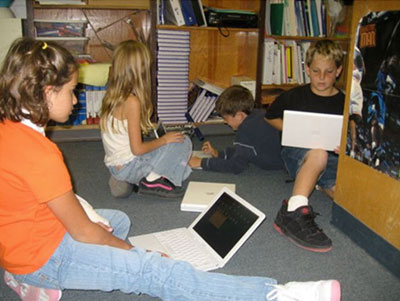
Routines in Michael’s Literacy Instruction
As soon as Michael enters his classroom, he takes out his laptop to pick up any files from the school server that his teacher has put there for the day and checks the class webpage (see Figure 2 for the layout of the class webpage). These files may include learning centers, writing prompts, graphic organizers, digital worksheets, URLs, media files (pictures, audio, or video), or corrected work. By bringing these files to his computer, Michael is ready for the teaching and learning expectations of the day. Michael then synchronizes his class calendar with the teacher’s so he has the up-to-date homework and event schedule.
Figure 2. The class webpage
Once these activities are complete, he checks to see what the morning sponge is (an activity to keep students engaged as Todd checks in with individual students). Today the sponge is centered on vocabulary, so Michael uses the thesaurus on his laptop for the word launched so that he can gain an idea of what this word means and learn about related words. He then uses his word processing application to write a sentence using this word, thereby demonstrating his understanding of its definition. Complementing the sentence is a nonlinguistic representation of the word that he creates by using a drawing application (see Figure 3). This activity and the class webpage demonstrate the hybridity evident in new literacies documents (Lemke, 1998), where students use word processing, drawing, or music in a single document.
Figure 3. Visual representation of vocabulary words
Shifting to More Formal Literacy Instruction During the Reading Block
Most days, Michael’s teacher leads the class through a short minilesson on a reading comprehension or vocabulary strategy before engaging in differentiated instruction. Today they read Just a Dream by Chris Van Allsburg from their basal reader. Before they start reading, students open up a timeline graphic organizer on their computers, which supports the week’s reading comprehension strategy-sequence of events. Students use instant messaging (IM) to pair-share during the reading of the story with their 8 o’clock buddy. (Todd has a clock for each student with a different person’s name near each time. When he says a time, students know their partner.) Todd begins reading and stops the class periodically for discussion and to add events to their timeline graphic organizer. They also pause when prompted by the teacher to use IM to share their thoughts and answers to questions with their partner. Most of this instructional process is familiar to teachers; what is novel is completing a timeline on a computer screen and having students use IM to deepen comprehension and foster engagement.
When the story is completed, Michael and his classmates spend a substantial part of their literacy block arranged in a Seat-Center-Circle organizational structure. Technology is integrated throughout the Seat and Center parts (those parts where students work independently), but not Circle. Circle is when small groups of students meet with the teacher and read and study leveled reading books. During Circle time, the teacher most often works on traditional literacy expectations grounded in print. However, during independent times, students engage in new literacies through the use of technology.
When working independently, Michael does one of three things. The first is to respond to a writing prompt on his computer that is directly related to the story or informational text read that day. Michael also completes a digital practice sheet or worksheet, a more traditional use of technology. The third activity is a book study. Students are offered multiple titles that are related to the theme of the core program from which to choose. As Michael is reading his book, he may use a Venn diagram (see Figure 4) or a comparison map to relate his chosen book to stories from the theme. Michael also joins a blog where other students reading the same book contribute and comment on each other’s postings (see Figure 5). Michael participates in center activities that are Internet-based and related to the week’s story and reading skills. The links that Michael uses are all on the class website so that he doesn’t have to spend time locating them.
Figure 4. Venn Diagram Comparing Maniac Magee to Other Characters
Figure 5. Example of a Book Blog for Lizard Music by Daniel Pinkwater
Breaks in Instruction
During recess breaks throughout the day, students are free to stay in the room and engage in noninstructional activities. Michael engages in sending IMs, checking and sending e-mail, and going online to enter kid-friendly virtual worlds like Club Penguin (www.miniclip.com/games/club-penguin/en/). Students, particularly those who do not have Internet access at home, enjoy engaging in these activities during breaks in instruction.
Differentiated Literacy Instruction
After recess Michael logs on to KidBiz Achieve3000 (www.kidbiz3000.com), a web-based, individualized reading and writing instruction program. First, he checks his KidBiz e-mail and replies to a question meant to stimulate background information for a current events article. After he finishes replying, he reads the article. This article is written at his reading level, so the whole class is reading similar articles but at different reading levels.
Similar to other teachers, Todd is expected to prepare his students for high-stakes assessment. He has Michael complete the thought questions from the KidBiz website. Thought questions are questions or writing prompts related to the article that call for students to use information from what they read to write a constructed response-a response that clearly answers the question. This is very similar to criterion-referenced test (CRT) constructed response questions and provides students experience with this expectation. For instance, the question that Michael responded to was, “National Basketball Association players are honoring soldiers during basketball games. Is this a good idea? Use ideas from the story in your answer.” After the class has finished their assigned KidBiz tasks, there is either a whole-class or small-group discussion of the article to extend meaning and explore answers.
Following this reading and responding, Michael opens the Internet browser and clicks on a link that takes him to a webpage with all of the stories his class is reading this year. He finds Just a Dream and clicks on Vocabulary from the pull-down menu. With this click, he is taken to a site called Flashcard Exchange, where his teacher has already entered vocabulary words for him to practice.
Writing Instruction
After this independent practice, Todd shifts to writing instruction. He begins by posing the question, “Have you or anyone you’ve known ever had an imaginary friend? Instant message your 3 o’clock buddy and tell him or her about this imaginary friend.” Then he leads a discussion about the writing trait, Ideas and Content, and tells the class to listen for good examples of this writing trait as he reads a picture book, Ted by Tony DiTerlizzi, about a boy with an imaginary friend. Although Todd wants them to do a Quick Write (first draft writing) on their laptops about an imaginary friend, he does not feel they are ready for this writing, so he has them return to the Internet to an interactive writing prompt found at www.writingfix.com. This particular prompt encourages Michael to describe his imaginary friend’s color, size, and amazing features. With this preparation in place, Michael and his classmates start the Quick Write. While everyone is writing, Todd confers with three to four students about their individual writing and ways to improve it. This activity demonstrates once again the seamless movement from traditional literacy practices, like reading a book, to new literacies through using IM and writing at a website.
As Michael’s class completes more Quick Writes, they are saved electronically into a folder to revisit later. Every two weeks or so, Michael is instructed to go back through his Quick Writes and pick one that he would like to take through the writing process. Michael then uses the software program Inspiration (www.inspiration.com) to organize and brainstorm his story or informational text. Following his first-draft writing, he revises using the built-in thesaurus to help with word choice and the built-in spelling and grammar check to edit his piece. Michael has learned that he has to be careful when doing these checks as he can’t just assume the computer is always correct. The next step in this process is peer review, where a fellow student reads and evaluates Michael’s writing electronically. Finally, after several revisions and edits, he is ready to print out and post his writing on the writing bulletin board in his class.
End of the Day Routines
Before leaving school, Michael picks up his homework from the server. Tonight’s homework is a graphic organizer that is to be filled out from a webpage. Todd saved a copy of the webpage for pickup because not all of Michael’s classmates have Internet access at home. Michael leaves school with his laptop tucked into his backpack, ready for out-of-school learning.
Getting there
In Todd’s words,
What makes today’s kids really sit up and fires their neural fibers? Technology. Kids don’t see laptops, MP3 players, cell phones, PDAs, DVD players, and video games as technology, it’s just life. Schools need to connect education to their students’ lives with technology.
That is exactly the path that Fernley Elementary School took. Following are some of the important details of this process.
Teacher and Principal Initiative
Todd shares this transformation to new literacies through his personal journey as an educator who wants to upgrade to a 21st-century model for teaching. He says,
I feel passionately that my job as a teacher is to prepare my students for their future. I started this journey 10 years ago when I began exposing my students to as much technology as possible. At the beginning, it was one Internet-connected desktop computer.
Fernley Elementary School was very much like any other public elementary school 10 years ago, one where teachers solely relied on books and paper for teaching. Todd began his quest to bring technology to his classroom with one computer with Internet access. The turning point came when Fernley received a new administrator, Alan Reeder, who had the desire and drive to improve student achievement through an infusion of technology and who was willing to provide leadership and support. The school targeted a goal that 80% of instruction in each content area would be supported with technology in fourth and fifth grades-an ambitious one for a rural Nevada school.
The first step was to start a computer lab (a classroom equipped with multiple computers with Internet access for teachers to use with their students) and purchase two mobile, wireless, laptop labs. Todd took over the teaching of the lab, where every class, K-5, visited once a week. He taught students to use technology as a tool to help them accomplish grade level expectations and to meet the essential learning outcomes required by district and state standards. At this time at Fernley, technology-supported instruction occurred most often in the lab with Todd, but teachers were also bringing technological innovations into their classrooms through the mobile laptop labs. They were encouraged in these first tentative endeavors by Todd, who nudged them to try and supported them as they did.
After three years teaching with the lab and mobile labs, the principal wrote a grant for 2 one-to-one laptop classrooms and received funding. Todd left the computer lab and took over in the fourth-grade one-to-one classroom. His transition to this classroom was supported by his three years in the computer lab, where he taught students digital and media technologies, and his previous teaching in fourth grade. As he began his new position, he brought a strong knowledge base of new technologies to his students (see Table 1 for many of the technologies to which students have access) and a current knowledge base of exemplary literacy instruction. His students brought their technological experiences from the computer lab setting as the foundation for their in-class extended experiences with laptops in the fourth grade.
Table 1. Applications and web support available to students at fernley elementary
| Support type | Resource |
|---|---|
| Applications |
|
| Keynote software |
|
| Web support |
|
Teaching in a One-to-One Classroom
What has each student’s access to a laptop meant for Todd’s teaching? It has made Todd rethink how he teaches everything, and it has made him a better teacher. He says,
Every week when I am lesson planning, I consider how I can best integrate the technology. I don’t use the technology just for the sake of using it. I want to use it in a way that enhances learning and best motivates students. I find myself borrowing ideas from colleagues, the Internet, and educational publications. I am a better teacher because I am making my students’ learning relevant to them and their times.
In listening to Todd, it is evident that the challenges of bringing technology to his classroom are also sources of creativity and enthusiasm. At first, Todd says that time management was an issue. It took him longer to plan, as he explains. “I had to think about all of the kids having laptops and infusing technology in real ways.” Coming from a lab offered Todd background in technological applications, but the sessions in the lab were typically for a half hour to an hour per week per class. Now he had to plan for full-day instruction with technology infused into all subject areas over the course of an academic year. Even with the initial time demands for planning and preparation, Todd finds himself, after three years of teaching with new literacies, still excited by the possibilities for student engagement and learning.
Preparation and Professional Support
Todd was not working alone through this major learning and teaching shift at his school. He received support from Apple when he became an Apple Distinguished Educator (ADE). For more information on what the ADE program is, visit Apple’s edcommunity. For Todd, the greatest benefit of being an ADE was attending their Institute to learn cutting-edge techniques for integrating technology and joining a worldwide community of educators who understood the importance of teaching students with today’s technology.
Apple didn’t just prepare Todd to teach with digital and media technologies, they came to Fernley and provided professional development for all the school’s teachers. The training involved a mixture of learning applications and ways to integrate laptop instruction with lessons and standards already being taught. With Apple’s support, Todd became responsible for continuous, on site, professional development. Each summer he offers a 20-hour technology-related workshop for teachers. In these workshops, he introduces teachers to learning with a laptop and shows them how to use its potential in daily instruction.
Simultaneous with this support, Todd created a group of students known as Wright’s Techies, students from his fourth-grade class who had moved up to fifth grade. Their responsibilities are to be tech-savvy enough to assist their fifth-grade teachers and classmates. They are expected to help with everything concerning the laptops, including knowing the operation of all applications and troubleshooting problems.
The training of Wright’s Techies is twofold. The majority of their training comes during their fourth-grade year, where they are exposed to how laptops and applications work. The second part occurs in the summer, a few weeks before school starts. Todd brings Wright’s Techies in for a day to review any changes to the laptops for the upcoming year. They also learn how to assist their new fifth-grade teachers and classmates, who will not be as familiar with the technology. Teachers are pleased with the resources brought to them through the support of the Wright’s Techies. They value the help with troubleshooting and teaching other students the technology so they can focus on content.
Preparing Students for New Literacies
When viewing a typical day for Michael, readers may wonder how a student came to be so proficient with new literacies. Fernley has carefully scaffolded new literacies for all students. New literacies instruction begins in kindergarten when students visit the computer lab or work on a laptop in their classroom. Students learn how to visit, explore, and learn from material shared on websites. They learn to write using word-processing programs. They also become familiar with multimedia projects, like those created with PowerPoint.
In third grade, students’ classrooms have eight laptops in addition to two student desktop stations. When visiting third-grade classrooms, it is common to see students investigating ideas using the Internet and reporting on their discoveries. Third grade serves as the transitional year where students continue to visit the lab and also have laptops available in their classrooms, thus becoming better prepared for fourth-grade instruction. In fourth and fifth grades, students work solely in their one-to-one laptop classrooms. Their teachers, with the guidance of Todd, extend students’ earlier experiences with new literacies and bridge intermittent laptop use to consistent use in fourth grade.
During these early explorations with technology, keyboarding techniques are shared with students and practiced somewhat. Todd observed that “keyboarding slows students down, and often their hands are not large enough for proper keyboarding.” Most students have some practice with keyboarding but are allowed to develop their own style. As Todd has worked closely with fourth- and fifth-grade students in one-to-one classrooms, he noted that, “their speed triples by the end of one year through their constant use of the keyboard.”
As seen in these entries into technology in the primary grades, students are prepared for its more extensive use when they enter fourth grade. During this year, their everyday use of digital and media technologies expands as they routinely create multimedia projects using various software programs. They create music, voice recordings, and podcasts. They create books and graphic organizers using Internet links and graphics. Finally, they become comfortable using blogs, e-mail, and instant messaging for sharing ideas.
When asked about his classroom and the changes to his students brought about by the use of new technologies, Todd says,
The number one thing laptops have done is motivation. Kids are sitting up and leaning into their learning. As a teacher, this is the one thing I want from my students. If I have them engaged and motivated, the sky’s the limit.
Students leave Fernley better equipped with the skills required in their futures. They know how to expertly search for information on the Internet, how to evaluate the reliability of different websites, how to find information on a website, and how to take notes from the Internet. Moreover, they know how to use word processing, spreadsheets, and presentation software (International Society for Technology in Education, 2007).
Do new technologies result in student learning?
What effects are seen on student learning is the big question for many educators who want answers before bringing new technologies to classrooms. This question is not an easy one to answer. Coiro (2005) indicated that there were improvements noted in comprehension when teachers were given instruction in new technology use. Teachers learned how to support students in comprehending Internet text that is not linear or fixed and, as a result, became more effective at facilitating comprehension on the page or screen. Warschauer (2006) also documented gains in motivation, writing competency, and critical thinking when laptops were used in the classroom.
However, the biggest hurdle when considering new technologies and student learning is that most assessments evaluate traditional literacy and content knowledge. For instance, in current assessments students read on the page and answer questions, or they write on paper to document writing proficiency. A better question related to assessment is, What can students do with new literacies that is not measured by current assessments (Leu et al., 2005)? For example, when thinking about writing assessment, although students are asked to handwrite a composition, the majority of writing today occurs on computers, and this type of writing is typical in one-to-one classrooms. So students in one-to-one classrooms are not able to demonstrate writing competency using familiar technological support because they must rely on traditional expectations. How much more sophisticated would their writing be if they could use the technological tools with which they are familiar?
To answer the important achievement question at Fernley, teachers routinely examine the assessments that students complete, both formative and outcome. Teachers use classroom-based assessment to refine instruction, and they use quarterly benchmark assessments tied to the district’s and state’s standards. Within this repertoire of formative assessments, classroom-based assessments are the only ones that target new literacies. The biggest challenge for Fernley is to make adequate yearly progress (AYP) as measured by the state criterion-referenced test (CRT) and writing test administered to fifth graders. Since 2002, Fernley has made AYP each year. During the 2006-2007 year, they qualified as a high achieving school for the growth in students who reached benchmark criteria. The most current CRT results indicated the following about the school’s fourth graders:
- 72% met or exceeded the benchmark criteria for English language arts
- 65% of those qualifying for free or reduced-cost lunches met or exceeded the benchmark criteria for English language arts
- 67% of Hispanic students met or exceeded the benchmark criteria for English language arts
When considering CRT scores, it is important to note that students were not asked to evaluate a website, read a website, or gain information from a website. Neither of the assessments, formative or outcome, asked students even to use a word processor. Neither of these assessments quantify students’ engagement as they learn. So until assessments include at least the first two components, it will be difficult to more precisely measure the additional knowledge students gain from using digital and media literacies. However, as shown by the data from this school, students did not regress on outcome assessments because of the inclusion of new literacies.
Essential Elements for Successful Implementation of New Literacies
The journey to new literacies through the use of technology happened at Fernley and can happen at other schools. Schools must consider their preparation for and response to several key elements before embarking on this journey (Hew & Brush, 2007). Fundamental to any implementation are resources that include access to sufficient technology, time for teachers and students to learn the technological applications, and technological support. At Fernley, the principal acquired the funding through grants and had a leader in place in Todd Wright. Moreover, Fernley carefully planned its initial support with Apple and continuing support and professional development with Todd for success.
A second issue is teacher knowledge and attitude about new literacies (Hew & Brush, 2007). Fernley presents a case study of working with teacher knowledge and attitude through a gradual model of moving to new literacies. Primary teachers are carefully supported with the lab and the gradual introduction of classroom laptops. In third grade, there are higher expectations for teachers to bring digital and media technologies to their classrooms. These efforts are carefully supported with Todd’s leadership, ongoing professional development, and student experts. By fourth grade, teachers are aware of the extended expectations for laptop learning and instruction, and students are prepared for this more consistent use of digital and media literacies. To bring new teachers to new literacies and to provide support for returning teachers, there are summer workshops to refine teachers’ knowledge about technology and explore ways to use it in learning. Todd similarly provides summer workshop support for student technology leaders.
A final issue is centered on assessment. The question of how students achieve on traditional assessments will affect those who make decisions about moving to new literacies. This question, although important, is losing its power as major assessments like the National Assessment of Educational Progress move to the use of computers (Olson, 2007).
Final encouragement
When Todd was asked why a teacher would want to take on learning about and using new literacies, especially with the additional work, time, and thinking required, he replied,
Teachers take on this challenge because it is their job to prepare students for the future. There is a steep learning curve at the beginning, but after the first year, most teachers won’t spend any more time preparing lessons. Once teachers have training in using laptops and how to integrate technology with state standards there is greater student engagement in learning. Teachers will see that giving a laptop to a student results in greater engagement. Greater engagement equals higher achievement. End of story.
Barone, D., & Wright, T.E. (2008, December). Literacy Instruction With Digital and Media Technologies. The Reading Teacher, 62(4), 292-302. doi: 10.1598/RT.62.4.2
